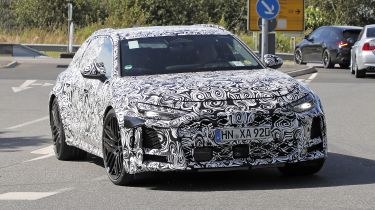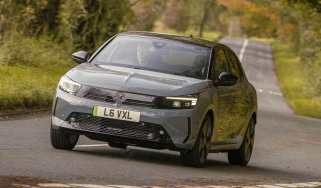2025 Audi RS 7 Avant looking mean with super-wide arches in new spy shots
Are we looking at a V8 with a plug-in hybrid system or a V6 for the new RS7? Only time will tell…
Audi’s next generation RS 7 Avant has been spied piling on the development miles complete with its blistered wheel arches and huge intakes that are only barely obscured by shape-shifting camouflage. As part of Audi’s huge product offensive that’s already kicked off with the new A5, the next generation RS 7 Avant seen here will effectively replace the old RS 6. It will rival the forthcoming BMW M5 Touring and Mercedes-AMG’s E53 Estate when it arrives in late 2025.
The main area of uncertainty, though, is what will power the new RS 7 estate. We know that, like its rivals from BMW and AMG, it’ll feature a plug-in hybrid powertrain. But where we know that the forthcoming RS 5 Avant packs a V6 plug-in hybrid system, it’s still up for debate as to whether Audi will use the same unit in the larger RS 7 – mirroring Mercedes-AMG’s E53 – or upsize to a V8 more in-line with the new BMW M5.
Audi doesn’t currently offer any V8 plug-in hybrid models but a new generation of V8 PHEVs have now hit the wider Volkswagen Group. The cars to get this new tech include Porsche’s Panamera and Cayenne, but also Bentley’s Continental GT and the forthcoming Lamborghini Temerario – although that particular system will be unique to Lamborghini.
If a V8 PHEV does find a home in this Audi RS 7 Avant, we suspect it’ll easily exceed 700bhp, and will probably share its general layout with Porsche’s Cayenne Turbo E-Hybrid, which has a 720bhp peak output. While the two cars will differ in their exact configuration, we suspect that they’ll share the Porsche’s relatively large 25.9kWh battery pack, which is capable of up to 60 miles of EV range.
We also know that the Audi RS 7 Avant will have its electric motor mounted between a traditional eight-speed torque-converter automatic transmission and a twin-turbo V8 engine, with power being sent to all four wheels. Audi’s Sport Quattro rear differential should be on hand to distribute drive between the rear wheels, with other high-end chassis tech such as rear-wheel steering and Audi’s clever Dynamic Ride Control system likely to be available, too.
However, an RS wagon is just as much about its bold design as its chassis tech and in this case we can clearly see Audi’s aggressive stance will remain intact. While we’re yet to see the standard Audi A7 Avant in official images, we have spied that car testing and this RS version will feature a bespoke body supporting significantly wider tracks.
The nose features a typical single-frame grille, and is flanked by large intakes to feed air into the powertrain behind. Looking at the side and rear, the overall shape of the new RS 7 is also more streamlined than previous RS 6 Avants. It has a more steeply sloped rear screen and shallower windows, helping give it a concept car-like look.
There are few surprises at the rear, highlighted by an Audi-typical light bar featuring OLED lighting elements like those already revealed on the new A5. The small rear exhaust pipes are likely to be place-holders for now, but will change into large ovals situated at the outer edges of the rear bumper, in classic RS fashion, for the production car.
With over a year still to go until its official reveal, there are still lots of questions to answer regarding the new generation Audi RS 7 Avant. And before it arrives, there’s a lot of other new RS models coming first, including the aforementioned RS 5 Avant, which will arrive with its own PHEV powertrain. Audi Sport is also finalising development of its upcoming all-electric RS 6 E-Tron in both Sportback and Avant forms, plus there’s an RS Q6 e-tron on its way, too. It’s all kicking off at Audi Sport.
Now discover the best fast estate cars currently on the market...





